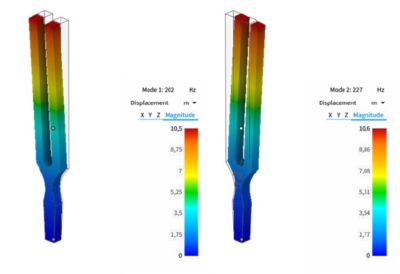Natural Frequency Analysis of a Tuning Fork with Ansys Discovery Software
Natural frequency is the frequency which an object will tend to vibrate when disturbed and allowed to oscillate freely. The fundamental natural frequency (or the lowest one) is usually the frequency at which the object vibrates most easily, requiring the least amount of energy to initiate its motion. It is determined by the object’s physical properties such as its mass, stiffness, and shape.
A tuning fork is a two-pronged metal instrument that produces a precise musical pitch when struck. The shape of the fork creates a sound wave with a stable frequency, often used as reference for tuning musical instruments. This case study analyzes the displacement and frequency of vibrations in a tuning fork resonator using Ansys Discovery™, a 3D product simulation software. The goal is to understand how prong length influences its natural frequency.
This case study uses results from a workshop run by the authors at the IDEAs Clinic at the University of Waterloo.
Learning Outcomes
- Perform frequency analysis simulations using the Ansys Discovery software
- Compare experimental and simulation data results
Applicable Courses for Use
- Dynamics
Downloadable Content
- Case Study Report
- Simulation Files
